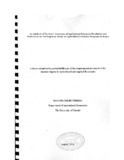| dc.description.abstract | In Kenya, agricultural extension has suffered various shortcomings including inadequate farmer
involvement in development and designing of extension programs. The current County
governance system in Kenya devolves agricultural sector to lower administrative levels with the
aim of bringing services, such as extension service closer to the people. Lack of empirical
evidence on farmers’ preferences for agricultural extension programs (AEP) limit policy making
on demand-driven extension. This study analyzed farmers’ awareness of agricultural extension
devolution and analyzes willingness to pay (WTP) for AEP by farmers in high and low potential
agricultural zones of Meru County in Kenya. Primary data were collected through household
surveys using a structured questionnaire. A binary logit model was employed to assess the
possible determinants of the level of farmer awareness of agricultural extension devolution.
Further, farmers’ preferences for various AEP scenarios were estimated using a random
parameter logit (RPL) model.
Results show that the awareness level of agricultural extension devolution is relatively low,
about 44 percent. Farmer and farm factors found to influence awareness include attendance to
farmer field days, tenure security (land title deed), income and education. The findings also show
that farmers prefer an extension program, which focuses on the agricultural activities they
engage in at the county level; where linkage support between the research, extension and farmers
is provided; and regular monitoring and evaluation of the program is scheduled. However,
farmers would like to be paid for their participation in developing the content of extension
programs. Education, source of market information and tenure security were found to be the
main sources of farmers’ preference heterogeneity between the two zones. These findings have
important policy implications for the design of AEPs for different categories of farmers. | en_US |



